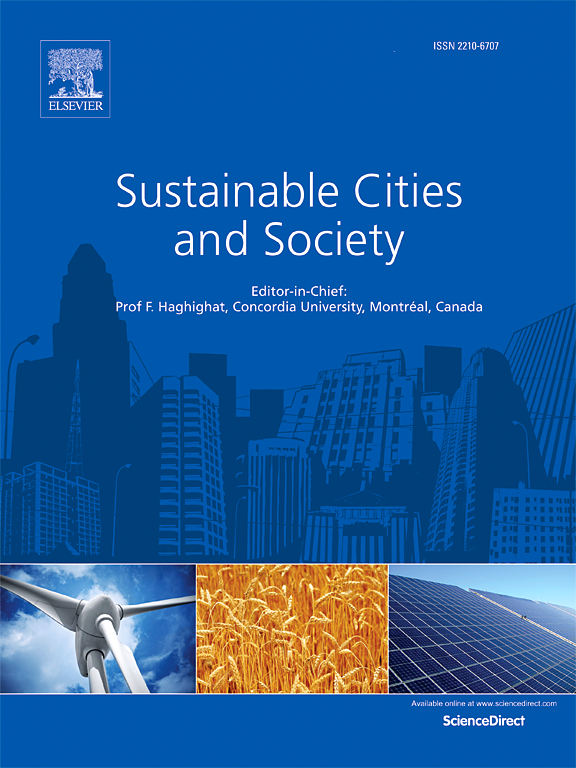Growth patterns and factors of electric vehicle charging infrastructure for sustainable development
IF 10.5
1区 工程技术
Q1 CONSTRUCTION & BUILDING TECHNOLOGY
引用次数: 0
Abstract
Rapid electric vehicle (EV) adoption necessitates efficient charging infrastructure. This study examines the growth patterns of EV charging infrastructure along with their socioeconomic drivers and strategic implications for long-term sustainable development. EV adoption rate (EV%) is used to analyze the growth metrics—Inflection Point, Convergence Point, and Saturation Point—to capture phases of initial expansion, stabilization, and plateauing demand, respectively. This study employs an allocation model to simulate EV charging station's (EVCS) distribution across EV% (5 %–95 %) for 20 Michigan cities, representing diverse metropolitan contexts. Results identify three key benchmarks: the inflection point (EV% = 25 %), where growth accelerates; the convergence point (EV% = 80 %), where growth stabilizes; and the saturation point (EV% = 100 %), where no additional EVCS is needed. Statistical analyses validate these benchmarks while revealing significant variability across urban contexts, driven by factors such as metropolitan density and high-traffic road ratios. Four growth patterns and strategies are discussed: large cities exhibit rapid acceleration, early stabilization, and swift capacity attainment due to high density; medium cities demonstrate slow acceleration, late stabilization, and extended capacity attainment; small cities experience rapid acceleration, early stabilization and swift capacity attainment, relying on transient traffics; and small hubs face slow acceleration, delayed stabilization, and prolonged capacity attainment, relying on external traffic, as transportation nodes.
电动汽车充电基础设施可持续发展的增长模式及影响因素
电动汽车的快速普及需要高效的充电基础设施。本研究考察了电动汽车充电基础设施的增长模式,以及其社会经济驱动因素和对长期可持续发展的战略影响。电动汽车采用率(EV%)用于分析增长指标——拐点、收敛点和饱和点——以分别捕捉初始扩张、稳定和稳定需求的阶段。本研究采用分配模型模拟了密歇根州20个城市EV%(5% - 95%)范围内电动汽车充电站(EVCS)的分布,代表了不同的大都市环境。结果确定了三个关键基准:拐点(EV% = 25%),即增长加速的地方;收敛点(EV% = 80%),即增长趋于稳定;饱和点(EV% = 100%),此时不需要额外的EVCS。统计分析证实了这些基准,同时揭示了城市背景下的显著差异,这是由大都市密度和高交通道路比率等因素驱动的。讨论了四种增长模式和策略:大城市由于人口密度高,呈现出快速加速、早期稳定和快速实现容量的特征;中等城市表现出缓慢的加速、较晚的稳定和较长的容量实现;小城市依靠暂态交通,加速快、稳定早、运力实现快;小型枢纽面临缓慢的加速、延迟的稳定和长期的容量实现,依赖于外部交通,作为运输节点。
本文章由计算机程序翻译,如有差异,请以英文原文为准。
求助全文
约1分钟内获得全文
求助全文
来源期刊

Sustainable Cities and Society
Social Sciences-Geography, Planning and Development
CiteScore
22.00
自引率
13.70%
发文量
810
审稿时长
27 days
期刊介绍:
Sustainable Cities and Society (SCS) is an international journal that focuses on fundamental and applied research to promote environmentally sustainable and socially resilient cities. The journal welcomes cross-cutting, multi-disciplinary research in various areas, including:
1. Smart cities and resilient environments;
2. Alternative/clean energy sources, energy distribution, distributed energy generation, and energy demand reduction/management;
3. Monitoring and improving air quality in built environment and cities (e.g., healthy built environment and air quality management);
4. Energy efficient, low/zero carbon, and green buildings/communities;
5. Climate change mitigation and adaptation in urban environments;
6. Green infrastructure and BMPs;
7. Environmental Footprint accounting and management;
8. Urban agriculture and forestry;
9. ICT, smart grid and intelligent infrastructure;
10. Urban design/planning, regulations, legislation, certification, economics, and policy;
11. Social aspects, impacts and resiliency of cities;
12. Behavior monitoring, analysis and change within urban communities;
13. Health monitoring and improvement;
14. Nexus issues related to sustainable cities and societies;
15. Smart city governance;
16. Decision Support Systems for trade-off and uncertainty analysis for improved management of cities and society;
17. Big data, machine learning, and artificial intelligence applications and case studies;
18. Critical infrastructure protection, including security, privacy, forensics, and reliability issues of cyber-physical systems.
19. Water footprint reduction and urban water distribution, harvesting, treatment, reuse and management;
20. Waste reduction and recycling;
21. Wastewater collection, treatment and recycling;
22. Smart, clean and healthy transportation systems and infrastructure;
 求助内容:
求助内容: 应助结果提醒方式:
应助结果提醒方式:


